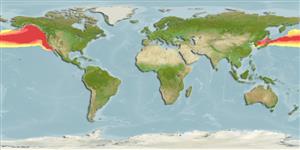Environment: milieu / climate zone / depth range / distribution range
Écologie
marin bathypélagique; profondeur 83 - 1800 m (Ref. 96339). Deep-water; 60°N - 30°N
Northeast Pacific: Gulf of Alaska to southern California, USA (Ref. 35612); including Japan (Ref. 43939).
Taille / Poids / Âge
Maturity: Lm ? range ? - ? cm
Max length : 22.2 cm SL mâle / non sexé; (Ref. 6885); 17.9 cm SL (female)
Description synthétique
Morphologie | Morphométrie
Épines dorsales (Total): 0; Rayons mous dorsaux (Total): 9-12; Épines anales 0; Rayons mous anaux: 8 - 10; Vertèbres: 44 - 47. Adipose fin small and sickle-shaped; pectorals small. Preserved specimens dark brown on body and head, lighter below, bluish on nape, preopercle, and throat, fins clear, eye silvery (Ref. 6885). Branchiostegal rays 3. Pyloric caeca 7-9 (Ref. 5123).
Found between the epipelagic and mesopelagic zones (Ref. 265). Oviparous, with planktonic eggs and larvae (Ref. 35612). Probably found at a depth of 100 m (Ref. 6885). A specimen of 17.92 cm SL was found to have mature ovaries (Ref. 5123).
Life cycle and mating behavior
Maturité | Reproduction | Frai | Œufs | Fécondité | Larves
Matarese, A.C., A.W. Kendall, D.M. Blood and M.V. Vinter, 1989. Laboratory guide to early life history stages of Northeast Pacific fishes. NOAA Tech. Rep. NMFS 80:1-652. (Ref. 265)
Statut dans la liste rouge de l'IUCN (Ref. 130435)
Menace pour l'homme
Harmless
Utilisations par l'homme
Pêcheries: sans intérêt
Plus d'informations
Taille/ÂgeCroissanceLongueur-poidsLongueur-longueurFréquences de longueursMorphométrieMorphologieLarvesDynamique des populations larvairesRecrutementAbondanceBRUVS
RéférencesAquacultureProfil d'aquacultureSouchesGénétiqueElectrophoresesHéritabilitéPathologiesTraitementNutrientsMass conversion
CollaborateursImagesStamps, Coins Misc.SonsCiguateraVitesseType de nageSurface branchialeOtolithesCerveauxVision
Outils
Articles particuliers
Télécharger en XML
Sources Internet
Estimates based on models
Preferred temperature (Ref.
123201): 0.4 - 5.5, mean 3.8 °C (based on 52 cells).
Phylogenetic diversity index (Ref.
82804): PD
50 = 0.5000 [Uniqueness, from 0.5 = low to 2.0 = high].
Bayesian length-weight: a=0.00389 (0.00180 - 0.00842), b=3.12 (2.94 - 3.30), in cm total length, based on all LWR estimates for this body shape (Ref.
93245).
Niveau trophique (Ref.
69278): 3.3 ±0.4 se; based on size and trophs of closest relatives
Fishing Vulnerability (Ref.
59153): Low vulnerability (17 of 100).
